“Our premise is that no one acts in a way that they know is wrong just to be wrong. … If they knew a harmonious way to achieve their goals with their horses, they would follow that way.” Emily Kitching, Eclectic Horseman

For two days I had been working hard at achieving the flow of the activity, but the goal of a soft feel and fluid motion remained elusive. As Jack and I continued to muddle around the arena, a voice came from outside fence “Would you mind if I made an observation?”
I had to stop and turn to where the voice came from as it was certainly not one I knew. “Please”, I responded as I was pretty sure any suggestion could improve on where we were at. With a single question, what had been painfully obvious to others was finally clear to me. The difference in outcome, nothing short of remarkable.
I was riding in a clinic with horsemanship master Buck Brannaman, but it was my ringside consultant who opened up the greatest possibilities for me that weekend. As horsemanship is all about our own behaviours, it was Chris’ simple suggestion that had helped me to adjust mine. The Zen saying: “When the student is ready, the teacher will appear.” fits as that one observation has lead to an ongoing dialogue with a friend willing to share his experience and wisdom.
While it may simply be a case of semantics, a term or a title can be everything. I was beginning to believe I was uncoachable however, being mentored is totally appealing. Founded in Greek Mythology, even the word mentor conjures up an image of admiration. Off to fight a two decade long war, Odysseus left his son Telemachus in the charge of faithful friend Mentor, to raise his son to be an honourable, truthful and courageous man.
Corey Olynik captures that appeal in his book “The Mentor’s Mentor”. The first chapter One Conversation Many Installments introduces the concept beautifully. Olynik’s view is the Mentor plays many roles through that Conversation. A role that begins as a Confidante and listens without judgement; is a Role Model with the experience to share, a Guide to help a protege see things for herself, a Tutor to facilitate learning, a Coach to bring accountability to the relationship and ultimately the overarching role of a Sage who keeps his eye on the vision.
Since that day last summer our conversations have covered many topics family, death, politics, the environment, the weather with a thread that always returns to horsemanship. Chris has some wonderful experience to share and his suggestions have greatly enhanced my learning and progress, he has asked the tough questions that make me think about my next step and overall he understands the ultimate goal we both seek in our relationship with our horse.
I have found yet one more Mentor to my horsemanship and leadership journey. Chris, it has been an unexpected and fun conversation, with what I hope to be many installments yet to come. Thank you.
My patience is infinite.
Buck Brannaman
Each month The Natural Leader publishes an article on our Blog and features it in our Monthly Newsletter. The theme typically relates to Leadership Learning through Horsemanship Activities. Every year we compile the best of the previous articles into an eBook. This is our reflection on the year 2011.
 Our eBook – In Business to Define – is ready. Thank you to all who contributed!
Our eBook – In Business to Define – is ready. Thank you to all who contributed!
For the inspiration: Jeff Nelson at www.Anduro.com
For pushing me to create something new: Steven Hobbs www.Wellthlearning.com
For your willingness to be included: Amanda Slugoski – www.EquinoxTherapeutic.com
Ann Romberg – www.WisdomHorseCoaching.com
Fiona Wren for your keen editorial eye.
 Reflecting on her goals from the day a participant of a recent Leadership: Horse Sense to People Smarts, session suggested that her confidence in dealing with difficult conversations and conflict in her team, improves “when I get out of my own way”. It was one of those comments that could have been my theme statement for the month! Getting out of my own way relates to both my horsemanship and business.
Reflecting on her goals from the day a participant of a recent Leadership: Horse Sense to People Smarts, session suggested that her confidence in dealing with difficult conversations and conflict in her team, improves “when I get out of my own way”. It was one of those comments that could have been my theme statement for the month! Getting out of my own way relates to both my horsemanship and business.
Watch a horse at play in the field and you will witness rollbacks, spins, levades, piaffes and counter canters with the greatest of ease. If a horse can execute these tasks without us, why is it so hard to achieve the same when we ask it of them? It is one of the most common and most difficult questions to answer, it always depends, and it always comes down to getting out of the horses way.
What I have come to understand about how we learn is we are often only prepared to hear what we need at that moment in time. Effortlessly galloping across the open prairie, horses mane and tail flying is typically the first image that comes to mind for those wishing to learn how to ride. Yet when they first get on that dream disappears and fear takes over. Whether it is fear of falling off or fear of failing, it is the emotion that can hold us back.
When fear grips us our first reaction is to hold our breath – the exact opposite of what we need to do. At a recent HRAC event, Shawne Duperon talked of the fear reaction we often experience when meeting new people. She calls the conscious action of breathing the Cycle of Reciprocity – you breathe to help the other person relax and breathe, breaking the tension that might exist.
It is exactly the same tension that shows up between horse and rider. While I often say there are only 5256 things you need to remember when on your horse, I make clear there is only one thing you must begin with and that is to breathe. It is the same thing I repeat often in our leadership programs. When people become conscious about a completely non-conscious action, breathing, they begin to realize the control they can exercise over their own emotions.
I love it when you identify something in a different context to see our own patterns of behaviour that may limit us. Horses benefit from clearly defined patterns of repetition. While I find huge comfort in the routine horses offer, I also see how it is a behaviour I have used as an excuse for the activities that are outside of my comfort zone.
Starting a business was totally outside my comfort zone and as I learned way beyond what I thought I knew. I have remained focused and intent on succeeding with my business and I have learned a lot through the process. I am also now painfully aware of my own short comings, but in a good way as I can choose to do differently. What is curious is the clarity comes as I hear others struggle with the same questions.
So this past month getting out of my own way has lead to many revelations, changes and new projects. I will soon be releasing my next workbook for people interested in learning with horses – In Business to Define; I have already confirmed 10 programs for 2012 and have a new partner in lining up business to fill in other dates.
As I learn to really listen to what it is I need I am finding it easier to let others help out so The Natural Leader succeeds. So thank you to everyone for waiting patiently as I figured that out!
“Be who you are and say what you feel because those who mind don’t matter and those who matter don’t mind.” Dr Seuss
 Are you a thought note person? I certainly am. When a thought strikes me as interesting I am prone to capture it. When I write these things down everything is perfectly clear as my internal editor is filling in the blanks where words of explanation should be.
Are you a thought note person? I certainly am. When a thought strikes me as interesting I am prone to capture it. When I write these things down everything is perfectly clear as my internal editor is filling in the blanks where words of explanation should be.
The problem is, I often don’t review those notes until some days or weeks later and the intention or meaning of the words may have all but disappeared. Without the context or intention behind the words, or perhaps it is simply the cryptic way I captured the thought, I sometimes have no clue as to why I wrote it down.
Our internal editor often causes us to skip the most basic of information, assuming we will simply fill that in later. Unfortunately it is the basics that the idea is built on and without that our thought lies incomplete, words on the page or just as likely in the notepad on our digital device.
To my surprise I realize I often execute tasks in the same way. Whether it is communication, projects or how I interact with others I can leave out key pieces of information that completes my expectation to ensure the success of others.
Actions than rang true for me with one of last years colts. Starting Gabriel last fall went really well. Typically I get a colt to a point and then let them mature on that over the winter months picking things up again in the spring. Well this spring we discovered a small hole that had become a gaping disaster when Gabe turned his back end into the carraganna hedge. A branch must have tickled him up under the flank turning my angel into a rank, bucking bronco an effort that would have made any Stampede cowboy proud. Fortunately for me, it was before I got on. An oversight I would not have been able to ride out.
We never want to put ourselves into a situation where we have to ride out a bad event, the problem is we rarely know when it is about to happen. It has now taken me twice as long to get Gabe back and riding to where we should have been from the start in the spring. Time well spent as for me it has been an invaluable lesson – never skip on the basics, never assume someone else really understands your expectation and remember to complete the thought.
When we turn our internal editor off it is so much easier to hear what you are saying, listen to the questions and watch for what others need. These three simple steps help us anticipate when a blank needs to be filled.
If you view it as an opportunity to start over – you always have another chance to complete a thought and make a good first impression.
Thanks to Steve Giddy for this photo


